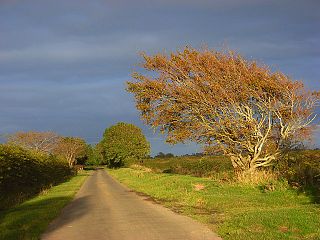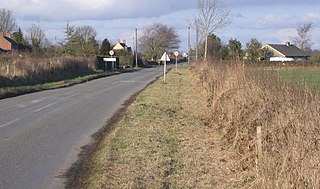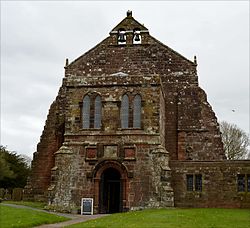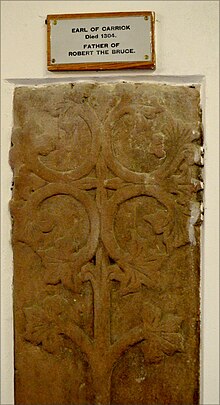
Abbeytown, also known as Holme Abbey, is a village and civil parish in the Allerdale borough of Cumbria, England.

Bromfield is a village and civil parish in the Allerdale district of Cumbria, in the north of England.

Aldoth is a hamlet in the civil parish of Holme Abbey in Cumbria, United Kingdom. It is situated approximately two-and-a-half miles south-west of Abbeytown, one-and-a-quarter miles south of Highlaws, and two-and-a-quarter miles north-east of the hamlet of Holme St. Cuthbert. Other nearby settlements include Pelutho, a mile-and-a-half to the north-west, Mawbray, four miles to the south-west, and Westnewton, three-and-three-quarter miles to the south. Cumbria's county town, Carlisle, is located twenty-and-a-half miles to the north-east.

Blencogo is a small farming village and former civil parish near Wigton in Cumbria, England. It is situated on the Solway Plain in the Allerdale Borough Council area, off the B3502 Wigton to Silloth road. The village is a centre for growing osier willow for basketmaking and related crafts. In 1931 the parish had a population of 139.

Mawbray is a village in the civil parish of Holme St Cuthbert in the Allerdale borough of Cumbria, England. Historically part of Cumberland. It is located on the Solway Plain, 5.2 miles (8.4 km) south west of Silloth, 7.9 miles (12.7 km) north of Maryport, and 25 miles (40 km) west of Carlisle. The B5300, known locally as the "coast road" runs to the west of the village.
Holme Abbey can refer to:

Newton Arlosh is a village in the civil parish of Holme East Waver in Cumbria, United Kingdom.

St John the Evangelist's Church is in the village of Newton Arlosh, Cumbria, England. It is an active Anglican parish church in the deanery of Carlisle, the archdeaconry of Carlisle, and the diocese of Carlisle. It was built as a fortified church, one of a number of such buildings near the Scottish border. It was restored and extended in the 19th century. The church is recorded in the National Heritage List for England as a designated Grade I listed building.

Holme St Cuthbert is a small village and civil parish in the borough of Allerdale, in the county of Cumbria, United Kingdom. The village is located approximately 23 miles to the south-west of Carlisle, Cumbria's county town, and was historically in the county of Cumberland.

Moss Side is a hamlet on the B5307 road, in the civil parish of Holme East Waver in Cumbria, United Kingdom. Nearby settlements include the villages of Abbeytown and Newton Arlosh.

St Mary's Church is in the village of Abbeytown, Cumbria, England. It is an active Anglican parish church in the deanery of Solway, the archdeaconry of West Cumberland, and the diocese of Carlisle. Its benefice is united with those of six local churches to form the Solway Plain Team Ministry. The church is recorded in the National Heritage List for England as a designated Grade I listed building.

Newtown is a hamlet in the civil parish of Holme St Cuthbert in Cumbria, United Kingdom. It is located approximately two miles north-east of the village of Mawbray, a little over half-a-mile as the crow flies to the south-east of Beckfoot, and twenty-five miles west of the city of Carlisle. The B5300 coast road runs approximately three-quarters of a mile to the west of the hamlet, which goes to Maryport, nine-and-a-quarter miles to the south-west, and Silloth-on-Solway, approximately four miles to the north.

Holme Low is a civil parish in the Allerdale borough of Cumbria, United Kingdom. It borders the parishes of Holme St. Cuthbert and Holme Abbey to the south, the town of Silloth-on-Solway to the north-west, and has a short stretch of coastline on the Solway Firth to the west. To the north, it is bordered by lands common to Holme St. Cuthbert, Holme Low, and Holme Abbey, which is an unpopulated area. Holme Low had a population of 373 in 137 households at the 2001 census, reducing slightly in the 2011 Census to a population of 362 in 162 households.

Tarns is a small farming settlement in the civil parish of Holme St. Cuthbert in Cumbria, United Kingdom. It is located two miles north-east of the village of Mawbray, and twenty-three miles south-west of Carlisle, Cumbria's county town. The B5301 road runs through the settlement, and along that road the town of Silloth-on-Solway is located five-and-a-half miles to the north, and Aspatria four-and-a-half miles to the south-east. Other nearby settlements include Aikshaw, Goodyhills, Jericho, and New Cowper.

The B5302 is a B road which runs for approximately twelve-and-a-quarter miles between the towns of Silloth-on-Solway and Wigton in Cumbria, United Kingdom. From west to east, it passes through the villages of Causewayhead, Calvo, Abbeytown, Wheyrigg, and Waverbridge, and also passes near to Blackdyke and Blencogo. At its eastern end, it comes very close to the Solway Coast Area of Outstanding Natural Beauty, and passes by Silloth Airfield, left over from the Second World War. Several of the villages that the road passes through were formerly served by trains on the single-track Carlisle and Silloth Bay Railway, which closed with the Beeching axe in the 1960s. It is the main road connecting Silloth-on-Solway and surrounding settlements with the A596, and by extension, the city of Carlisle.

Holme East Waver is a civil parish in the Allerdale borough of Cumbria, United Kingdom. It is bordered to the north by the civil parish of Bowness-on-Solway, to the east by the civil parishes of Kirkbride, Woodside, and Waverton, and to the south by the civil parishes of Dundraw and Holme Abbey, lands common to Holme St. Cuthbert, Holme Low, and Holme Abbey, and the town of Silloth-on-Solway. At the 2001 census, it had a population of 306 in 121 households, increasing slightly at the 2011 Census to a population of 318 in 130 households. It is named for the River Waver, and the rivers Waver and Wampool enter the Solway Firth at the western end of the parish. Part of the Solway Coast Area of Outstanding Natural Beauty is within the parish of Holme East Waver. The largest village is Newton Arlosh.

Highlaws is a hamlet in the civil parish of Holme Abbey in Cumbria, United Kingdom. It is situated approximately two-and-a-quarter miles south-west of Abbeytown, one-and-a-half miles east of Pelutho, and one mile to the north of Aldoth. Other nearby settlements include Mawbray, four-and-a-quarter miles to the south-west, Blitterlees, three miles to the north-west, Blackdyke, two-and-a-quarter miles due north, and Foulsyke. Carlisle, Cumbria's county town, is located twenty miles to the north-east.
Holme Abbey is a civil parish in the Borough of Allerdale in Cumbria, England. It contains 15 listed buildings that are recorded in the National Heritage List for England. Of these, one is listed at Grade I, the highest of the three grades, one is at Grade II*, the middle grade, and the others are at Grade II, the lowest grade. The parish contains the village of Abbeytown and smaller settlements, and is otherwise rural. The most important building in the parish was Holmcultram Abbey part of which has been converted into a parish church, and other parts have been used in other buildings. Most of the other listed buildings are houses and associated structures, farmhouses and farm buildings.

Kelsick is a hamlet in the civil parish of Dundraw in Cumbria, United Kingdom. It is located approximately 1.8 miles (2.9 km) southeast of Abbeytown, 0.9 miles (1.4 km) northwest of Dundraw, and 14.5 miles (23.3 km) west of Carlisle, Cumbria's county town. Kelsick is accessed by two side-roads off the B5302 road, which runs between Silloth and Wigton.




















